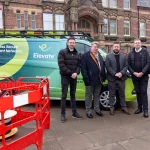Horton Village Angry at Superslow BDUK and BT Broadband Upgrade
Some 150 residents of Horton, a small and quite remote rural South Gloucestershire (England) village, have expressed anger at the performance of BT’s recent Broadband Delivery UK (BDUK) funded upgrades that are reportedly failing to deliver the promised “superfast” (24Mbps+) speeds.
At present the Government’s national BDUK scheme aims to make fixed line broadband speeds of greater than 24Mbps (Megabits per second) available to 95% of the UK population by 2017. In relation to this the local authority is working to extend BT’s “superfast broadband” network to 94% of South Gloucestershire by the end of March 2015 and it’s likely this will be extended again in the very near future.
Advertisement
Crucially that still leaves 6% to suffer sub-24Mbps speeds (the minimum commitment is at least 2Mbps) and like it or not somebody has to live in the 6%, at least until the national target is enhanced to reach everybody. Unfortunately this appears to be the case in Horton, where locals had been expecting something “superfast” but instead appear to have been left out in the slow lane.
Steve Webb, Thornbury and Yate MP, said:
“I sat in my office in Yate with a man from the council and a man from BT and asked the question – and the man from BT phoned his head office and the message came back that he was not allowed to tell me. We want to know the actual number of people who are getting the superfast speeds of 24Mbps.”
A BT Spokesperson said:
“I understand everyone’s frustration. We are battling with the laws of physics and we will push things as far as we can.
More and more villages are coming online and we’re getting down to individual line solutions now. We are doing the best we can.”
It’s important to remember that BTOpenreach tends to conduct their upgrades in stages and the South Gloucestershire roll-out is still on-going. In fact earlier this week we picked up on a small announcement that appeared to confirm how Horton would be in line for a broadband upgrade (here), although oddly the above article doesn’t reflect that.
Meanwhile many rural residents remain frustrated that bigger towns and villages are taking priority, although the inside-out approach to deployment tends to make more commercial sense for big providers like BT; as opposed to skipping the key bit in the middle where you have the most customers (note: urban areas can suffer slow speeds too).
At least in this example there should be a happy ending, while others will have to wait a lot longer to see an improvement.
Advertisement
Mark is a professional technology writer, IT consultant and computer engineer from Dorset (England), he also founded ISPreview in 1999 and enjoys analysing the latest telecoms and broadband developments. Find me on X (Twitter), Mastodon, Facebook, BlueSky, Threads.net and Linkedin.
« Luxury Goods Maker Wants ISPs to Block Websites for Trade Mark Abuse


















































Comments are closed